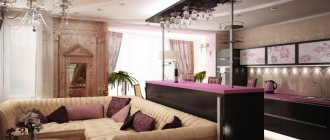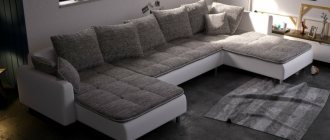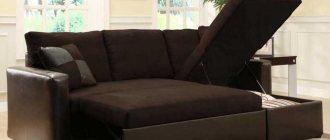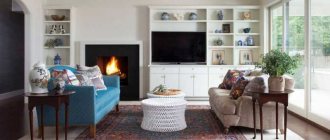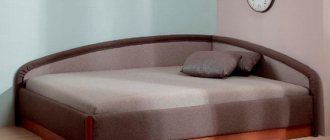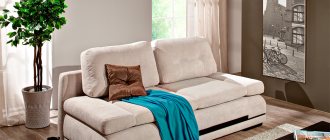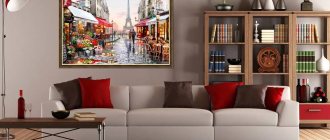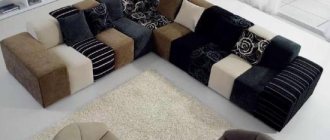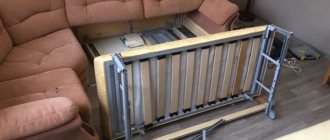In the 21st century, convenience and comfort have become the subject of a separate science - ergonomics. Now the shape and arrangement of the things we use are studied and compared to deduce the ideal proportions of furniture and the best layouts of buildings and rooms. You can take advantage of the works of scientific thought: we offer you an article on how best to arrange a sofa in different interiors. It depends not only on the purpose of the room, but also on its shape, size, your goals and, of course, on the configuration of the furniture.
Ways to arrange a sofa in a room
The sofa is often called the “living room”, and sometimes even its “king”. But this does not mean that it must be placed in the middle. There are three main types of sofa placement in the interior:
- Along the wall. Classic sofa arrangement: the back is parallel to the longest wall.
- In one of the corners. This is how sofas are placed in small rooms and, as a rule, these are corner models.
- Island placement of the sofa. The “heart of the living room” is located in its middle or in the conventional reception area.
- U-shaped. For furniture of the appropriate shape: it occupies one wall and partially the other two, or a niche, or three sides of the “guest area”. Not only U-shaped sofa models are suitable for this type of placement; you can also use several small straight sofas or complement the sofa with armchairs on the sides. The result is a conversation area.
Not every sofa can be placed in any of these positions. Therefore, before buying it, decide where it will be located. This will help you choose the right model. Its placement determines how rationally the space will be used and whether it will seem too empty or cluttered. Therefore, the choice often depends on the shape and size of the room.
What not to do in a rectangular room
A rectangular room is still a disproportionate room; some arrangement techniques can completely distort its proportions, and as a result, make it uncomfortable for living. In order not to make your own mistakes, we offer you a list of recommendations on how not to place furniture in a narrow room.
- Refuse the symmetrical arrangement if you do not plan to highlight functional areas. This technique is good for square rooms; it harms elongated ones, stretching them out even more. Do not use tall structures. Bulky cabinets and slides along the wall will create a “vestibule effect,” but it’s unpleasant to live in.
- Don't use the furniture set. A whole series of sofas, armchairs, and other elements weighs down the room and looks as boring as a room covered with one type of wallpaper. These techniques have their place, but not in a narrow room. On the contrary, it should be diversified, enlivened with original wall decor, an interesting combination of furniture, in order to distract from incorrect proportions.
- Don't clutter the room. A large amount of furniture, even if it is in harmony with each other, is unacceptable for a narrow space. It is important to find the line between natural balance and disorderly clutter. Don't give in to the feeling that it's cozy when every gap is filled. Because over time, these items will begin to interfere, and staying in the room will not be enjoyable.
Now you know how to place a corner sofa in a rectangular room, and you will be able to implement original ideas in your apartment, and Zlatamebel will readily provide high-quality furniture
Choosing the method of placing a sofa according to the type of room
The selection of upholstered furniture according to the parameters of the living room, kitchen and bedroom is based on the laws of logic and ergonomics. Items should be placed in such a way as to leave passages clear and so that guests can comfortably approach each one. Here are some recommendations from interior designers that they most often follow in their work.
- For medium-sized rooms, square or elongated, a position “in the corner” or “along the wall” is suitable.
- If the room has many niches and has a complex shape, install a modular sofa along the wall: it can be easily adjusted to the shape of the walls and harmonize extra corners.
- The shape of a very narrow room can be softened by placing U-shaped upholstered furniture “at the end”.
- In a small room, the “king of the living room” will inevitably stand in the corner. The most compact option is a small rectangular one, with 2-3 seats. But if it is corner, this will increase the number of seats for guests.
- Island models look great in a very spacious room or open space (studio, loft, hall). But furniture placed in corners or along walls should be avoided so as not to create a feeling of emptiness.
The sofa can be placed not only in the living room, but also in the kitchen, bedroom, and nursery. For them, the general recommendations are approximately the same, but we will talk about the differences below.
Of course, when choosing, you need to be guided not only by the shape of the room. No less important is the functionality of this upholstered furniture and its role in your interior. And the features of the room can usually be adjusted in other ways: selection of cabinet furniture, arrangement of interior items, choice of finishing materials, lighting. Harmonization of space is important, but the sofa must first of all fulfill its direct function - be comfortable for sitting or sleeping. Therefore, before purchasing it, answer the most important question for yourself.
Nuances of furniture placement depending on the type of room
How to properly arrange furniture in the room depends on both the layout and the type of housing. A private house usually has much more space than a small Khrushchev house. But both there and there you can create beautiful interiors.
Living room in a private house
It is recommended to make some element the center of the room, for example, a fireplace, table, TV. All furnishings will already be grouped around. A sufficiently large room can be divided into functional areas and furniture can be placed in accordance with their purpose. For example, a living room may have a dining area for entertaining and relaxation. In the first one, you cannot do without a table, chairs, a cabinet or a cupboard for dishes. In the second zone, bookshelves will come in handy, perhaps even a grand piano or an upright piano, if one of the household members is interested in music. In the third, soft poufs, armchairs, and sofas will take their place. In this case, each of the sectors must be connected to the central element of the hall.
Studio
To make your studio comfortable to live in, it is extremely important to furnish it correctly. For example, a kitchen corner can be placed against one of the walls, a sofa against the other, and a TV and possibly a slide opposite it. For one person living, this option would be quite suitable. The studio combines a living room, a kitchen, and a bedroom in one space, so it is worth considering the location of household appliances.
About a meter will be needed to use the oven, dishwasher or cabinets. You need to make sure that nothing prevents them from opening freely.
There is a concept called the “work triangle”. This includes the sink, refrigerator and stove. It is desirable that moving between them is quick and convenient. The most necessary furniture in a studio apartment: a kitchen corner, one sofa or bed and a shelf (wall-slide).
Variety of cabinets in the hall, their internal contents and design
Narrow room
Furnishing a narrow space in an apartment with furniture is not an easy task. You need to try to visually smooth out the lack of balance. A closet or dressing room located at the end of the hall can help with this. Rounded furniture pieces with smooth curves will distract attention from imperfect proportions. To avoid the effect of a corridor, small lamps are used, located on narrow walls. Mirrors will be a real salvation in such a room.
Dividing the hall into two zones will turn its disadvantages into advantages. For example, it will be convenient to arrange corners for relaxation, lunch, and dinner. Different wall colors and podiums, but not solid partitions, will help differentiate them. It is recommended to paint long walls in soothing colors, and short walls in bright colors. It is better to lay parquet perpendicular to the larger sides of the room. For such a room you need a closet the size of the end wall, a narrow sofa, small lamps, and a mirror.
Spacious hall
The large space gives room for flights of fancy. You definitely shouldn’t place all the furniture along the walls, leaving the center of the room empty. A circular composition will add coziness; zoning will work well. A long sofa, wardrobe or screen will come in handy here.
Tables and chairs that are too small and do not match the scale of the room will look funny and awkward. Although you can put almost anything in a spacious living room, you should choose a classic set. It consists of a large sofa, several wardrobes, soft armchairs, a table (work or kitchen), and a coffee table.
Room in a small family
In order not to lose a single square meter, it is absolutely necessary to properly decorate the room. Storing things requires rational organization: you will need built-in closets, sofas with drawers at the bottom. But you shouldn’t sacrifice natural light and block the window with a huge wardrobe or place it so that it is impossible to open the door. The entire set should be miniature, in calm tones. L-shaped and folding designs will not be the best choice. Any cramped room will be visually slightly expanded by mirrors. One sofa, wardrobe and coffee table will be enough.
If you place furniture in the room rationally, taking into account its purpose and dimensions, any layout can be made convenient and comfortable. The main thing you should focus on is the proportionality of objects to the room, functionality and good lighting. If you take into account all these criteria, the interior will definitely turn out successful, and a well-chosen style, a uniform color scheme and small accessories will make it cozy and beautiful.
Choosing a seat for a sofa by function
When deciding where the sofa will be in the room, think about what tasks it will solve. In short, what do you need this piece of furniture for?
- If groups of friends and relatives often gather in the living room, the “soft group” (sofa and armchairs) will be the main part and occupy the main space. Usually it is grouped around a compositional center: a TV, a fireplace, a table.
- The living room in a modern apartment can serve as a bedroom for guests or for the owners. If people will often sleep here, place the bed so that it can be folded out comfortably and the sleeper will feel comfortable.
- In the case when the “king of the living room” is not the main, but additional furniture (for example, in the kitchen and bedroom), it is placed so that it does not clutter up the space and does not interfere with the passage to other areas. Typically this location is corner or along the far wall.
- If you want to zone a large room with furniture, a sofa is one of the proven ways to define a relaxation area. And you need to place it where it will be comfortable to relax: the area should not be located close to the entrance and should not be a passageway.
Some sofas leave a lot of room for changing the space: they can be rearranged in different ways. We are talking about modular and island models. If you think that your life may change dramatically in a couple of years - for example, moving from a noisy bachelor life to a more measured family life - take a closer look at the modules. With them you can easily turn a room for noisy gatherings into a cozy place for two.
Basic Rules
There are three main options for how to correctly arrange furniture in the room:
- Symmetrical. Arranging furniture in pairs in square rooms is a good interior solution. It creates a feeling of comfort, reliability, and a working atmosphere.
- Asymmetrical. Creative people will like this arrangement of furniture in the hall; it looks great in spacious living rooms of an original shape. To prevent the lack of symmetry from becoming chaos, a compositional center must be selected and a competent balance must be created. Small pieces are placed together, preferably next to bright areas of the walls. Large ones, on the contrary, require a calm background.
- Circular. It assumes the presence in the center of the hall of a correctly chosen object around which others will be grouped. Usually this is a table or chandelier. This design of the hall will create comfort and will highlight what the owner of the house is proud of.
Features of living room furniture in a modern style, tips for choosing
There are general recommendations that are relevant for all types of compositions:
- Furniture placed diagonally visually increases the space of the hall, as do mirror surfaces.
- The dimensions of cabinets, tables, sofas must correspond to the living space. A set that is too massive cannot be beautifully arranged in a Khrushchev building; it will look ridiculous.
- Partitions and shelves will help create functional areas (dining, relaxation, work) to conveniently organize life even in a small space of the hall.
- You should not cover natural light sources with furniture; their light is the most advantageous and pleasant.
- Nothing should interfere with the comfortable movement of people.
Asymmetrical
Circular
Symmetrical
Philosophical approach. How does Feng Shui recommend placing a sofa?
The subtleties of furniture arrangement are dealt with not only by design and ergonomics, but also by more exotic sciences. For example, the eastern teaching of Feng Shui recommends its own rules in order to rid the house of negative energy and make it more attractive to guests. Feng Shui will tell you how to position the sofa correctly.
From the point of view of Feng Shui, the “king of the living room” should be located along one of the walls, but so that its back is not turned towards the window or door. Otherwise, as adherents of the doctrine believe, the furniture will interfere with the circulation of energy. Therefore, the best place is along one of the long walls of the room. Feng Shui also recommends choosing furniture with legs so that the flow of energy can flow freely along the floor.
The disadvantage of this approach is that Feng Shui does not take into account the shape of the room. By placing a sofa along a blank wall in a long narrow room, you risk visually stretching it out even more. And in studios and lofts, placing objects along the walls is not always a good idea; it can create empty space in the center.
Long rectangular hall
In a narrow, elongated, rectangular room, furniture is usually placed along the walls. Lightweight modular furniture allows you to experiment with movement; it is not necessary to display cabinets in one line. The sofa can be placed in front of the TV, creating the perfect corner for a movie lover.
Long rectangular hall - furniture arrangement option, photo
Furniture for small rooms often has rather streamlined shapes. Round or oval tables look great in a small interior and give a rectangular room a slightly different shape. Streamlined furniture shapes help add a pleasant lightness to a small space.
Furniture arrangement in a rectangular room, photo
Before decorating a room, it is worth studying a few rules about the optical expansion of the interior.
- The most common approach is to paint long walls with light paint, short walls with dark paint, so the room will be visually shortened and the proportions will become more even. Short walls will visually bring you closer together, long walls will allow light to visually make the room wider and more spacious. You should place a tall, dark-colored built-in wardrobe against a short wall.
- A good solution is asymmetrical furniture, which allows you to improve the proportions of the interior and make the room unrecognizable.
- It is important to properly organize the lighting. The number, size, and location of windows play an important role in a long, narrow living room. Typically the window is on the short side of the room. This arrangement of windows makes the room darker on the opposite side. Therefore, you need to use light wallpaper, paint, and light furniture on the far wall. Horizontal stripes placed on a short wall will neatly optically push the walls apart.
- You should avoid many small decorative elements that give the feeling of overloading the space.
- It is advisable to choose smooth, shiny, light-reflecting furniture facades. This will make the room look wider.
- It is advisable that the colors of the furniture be light.
- The distribution of individual components should be concentrated on short walls. You can expand the interior: a wide mirror on a long wall, decorative shimmering elements placed on the longitudinal walls - paintings, decorative elements.
If a long narrow room needs to accommodate a tall cabinet, it is better to place it next to the door. A common mistake is to install furniture along a long wall - this deepens the tunnel effect. It is necessary to create several zones using asymmetrical furniture and carpets that highlight specific areas of the room.
We place the sofa from a design point of view
If your house is decorated in a classic style, the arrangement of furniture in it should be symmetrical: this is one of the important principles of a traditional interior. Therefore, the place of the sofa in a classic living room is in the center of a soft group (chairs are placed on either side of it), and the entire set of furniture for relaxation is symmetrical relative to the walls.
If the principles of proportionality and your philosophical and design preferences point to the same place in the room, you're in luck. If not, then you will have to make a difficult choice between beauty and convenience. We advise you to give priority to functionality, because you are creating a space for living and relaxation, and its main task is to be comfortable.
Placing individual elements
A certain set of furniture is usually placed in the living room. Each element must stand in its place and be combined with others. In addition, you need to maintain a unified style for the interior of the hall, and this can be quite difficult.
Sofa
There are several main types of this piece of furniture:
- Corner sofa. This design saves space and is perfect for a small apartment. You can only place furniture in the middle of the room in a very large room; in other cases it is better to place it in a corner.
- Classical. It will be appropriate everywhere, unless you take into account how big the apartment is and whether the sofa can be folded out.
- Island sofa. Such furniture is not created for a small room; it will not be possible to arrange everything so as to provide access to it from all sides. The sofa can be placed in a room where there is a lot of free space.
- Modular. Due to its moving parts, such a sofa can take the desired shape. This is an excellent option for living room furniture to create a cozy place for reading, relaxing and chatting.
Classical
Modular
Ostrovny
Angular
TV
The TV can be made the central element of a circular composition or hung on the wall if we are talking about a modern thin model. Sometimes it is installed in a special niche provided in many shelves and slides. One more aspect should not be missed - the screen should not be blocked by anything; it is reasonable to place an armchair or sofa in front of it.
Dining table and chairs
It is important to arrange furniture beautifully both in the living room and in the dining room. Moreover, if these roles will be performed by the same room. If your windows have a great view, you can place a table and chairs in front of them so you can enjoy your meal in natural light while watching the action outside.
Modern cupboards for the living room, types of designs
When arranging furniture, you should always think about the ease of use. From this point of view, a table in the center of the hall is ideal: guests will not crowd around it, and in order to leave, they will not need to disturb anyone. A lamp is usually hung from above; a beautiful lampshade in warm colors is suitable for a cozy homely atmosphere. Of course, this idea is not for small rooms. Furniture placed in the corner is suitable for them: for example, an L-shaped sofa and a dining table next to it. For narrow rooms, elongated, narrow models that can be pushed close to the wall are suitable. To avoid forcing diners to stare into space, you can hang pictures.
Wall or slide
First of all, you need to think about what will be stored there in order to choose the appropriate furniture model. For example, it may contain a sideboard for dishes, bookshelves or a wardrobe. Its design and material of manufacture depend on the weight that the wall has to withstand. If it is not too large, it can be a hanging cabinet, visually expanding the room. For large halls, a corner slide or several structures moved to adjacent walls are good. It is better for them not to stand close to each other, then there will be more air.
Today, wall models with legs are gaining popularity; in addition to their design, they are distinguished by ease of rearrangement.
Seven times measure cut once
So, the answers to the main questions have been found: you have approximately determined the dimensions of the future sofa, its shape and place in the room. Now it’s time to remember that you will have other furniture, and think about the relative position of the sofa relative to other interior items.
It is best to mark using a plan: on paper or in a special program. First, carefully draw a diagram, observing the dimensions and indicating windows, doors, heating radiators, and ventilation shafts. After that, try to draw the arrangement for all the furniture. The most convenient scale is 1:20.
Arrange the furniture so that it is convenient to approach it and that there is free space for opening closet doors and unfolding the bed. In this regard, a computer program is more convenient than pencil and paper, because everything in it can be moved with one mouse movement, and also shown in the form of a drawing and in the form of a 3D model.
It is not advisable to place the sofa close to the window opening, because it will cover the radiator and make it difficult to access the window for ventilation. Also make sure that it does not interfere with the opening of doors and balconies.
Drawing a plan is the best answer to the question of how to properly place a sofa: you will immediately understand what dimensions the model will suit you and whether it will be straight or angular. If you find it difficult to arrange furniture yourself, contact a designer for help.
#2. Zoning a rectangular living room - photo examples
in the photo: zoning of a modern living room
Furniture with large details makes this room modern, although subtle lines would add sophistication to the interior.
in the photo: zoning the living room in gray tones
This modern room is beautifully decorated. The palette of gray tones with elements of blue and yellow looks interesting and stylish.
in the photo: zoning an elongated room
Long living rooms like this one benefit from subtle pieces. Please note that the TV panel, carpet and furniture are made in a non-standard elongated shape.
in the photo: zoning of a cozy and modern room
The design of this living room is simply irresistible. The furniture is great too. And although the color scheme is somewhat dark, the room is good just like that – modern and cozy.
in the photo: decorative elements in the zoning of the living room
Chicagoans love to mix modern decorative elements with vintage ones, as in this room.
in the photo: zoning a room in a minimalist style
This modern minimalist room in beige tones is a great example of a long living room. Sometimes rectangular rooms are more difficult to decorate than square ones, so minimalism is very appropriate here.
in the photo: zoning a rectangular room
If your budget does not allow you to purchase luxurious armchairs, you can furnish the room with stylish backless chairs and benches. This room uses a great color scheme and also features narrow rectangular pieces throughout, like the previous designs.
Double sofas with ottomans and coffee tables look charming, and the neutral colors used in the design create an atmosphere of comfort and peace.
The interior of this room evokes a feeling of cleanliness. According to the designer, the owners turned the old terrace into a beautiful full-fledged living room.
in the photo: zoning a long and wide room
This room is not only long, but also quite wide. The seating area is also unusually long, and a low stand against the wall helps to visually soften the protruding corners.
Although decorating a long living room is not easy, such rooms have advantages. For example, they are good for large companies. Organize several seating areas in the living room. This will allow guests to communicate in groups based on interests. This spacious room has two separate seating areas. A minimum of furniture leaves enough free space.
It was not easy to find a suitable sofa for this long narrow living room. The designer created two separate seating areas using Molteni & C Freestlyle modular furniture. A sectional sofa can be remodeled in an infinite number of ways to suit any situation.
Undoubtedly, everyone dreams of having at their disposal a spacious home with an open layout. Such that there is somewhere for every person’s inner designer to roam and bring any ideas to life.
But in reality, most often we end up with an area where we can’t really imagine it. Ordinary apartments with rectangular elongated rooms or a kitchen, the space in which to expand by demolishing walls is extremely dangerous.
When creating the interior of a living space with elongated shapes, it is best to use methods (very effective and uncomplicated), with the help of which you will be able to deal with all the difficulties caused by poor planning.
The shape of the room can be visually changed by choosing the right range of colors. To make your rectangular layout seem square, you need to paint the elongated walls in light colors and the short ones in dark colors.
Contrasting tones always introduce some movement into a room, visually complicating its shape and thereby visually increasing the space. Don't be afraid of bright colors and stains.
The difference in wall thickness also has the same feature. There is no need to be afraid that niches will steal your space. Visually, on the contrary, they will expand the space, minimizing the feeling of elongation.
The most effective method when working with small areas is the use of large mirrors. If you place them on a long wall, it will seem that you have much more space.
A good choice when creating a narrow-shaped interior would be bright photo wallpapers. They can serve as an extension of the space of your room, for example, by adding an entire oak forest to the bedroom.
In cases where the flooring is parquet or laminate, its elements should be installed parallel to the narrow sides of the room. In this case, it is possible to create separate zones; paths and rugs are best suited for these purposes.
When decorating windows, remember that horizontal stripes always expand the space.
Natural light always visually expands the room, so it is best to leave the window open at all times.
Most often, to save space, people try to arrange furniture along long walls; such an apartment will soon resemble a reserved seat carriage.
To prevent this from happening, space should be allocated perpendicular to the long walls for a small sofa or table. A corner sofa will also fit very well into an elongated interior.
In sharply rectangular rooms, it is advisable to smooth out all the corners. A rounded coffee table and an oval mirror can easily correct straight, strict lines and avoid a tunnel effect.
The main problem when choosing furniture for a small room most often becomes the organization of free passage from one end of the room to the other. It will be better if the trajectory of movement around the room lies in a straight line. Otherwise, you will most likely suffer frequent injuries in the form of bruises and contusions while maneuvering between incorrectly placed furniture.
To avoid clutter with cabinets and chests of drawers, you should use the entire volume of your room, from floor to ceiling. A good idea would be to replace low shelving with shelves.
A good option for rectangular elongated projects would be wardrobes located along the narrow sides. They will simultaneously give the room a more regular shape and solve the issue of storing things in a small apartment.
It’s good when in your house or apartment all the rooms are of a standard shape, close to square, and there are no “pencil cases” - narrow and elongated rectangular rooms. If your home has such a rectangular room
, there is no need to despair: with skillful handling, it can become no less cozy and comfortable for perception and, accordingly, living in it.
The first step is to think about the design of a rectangular room
so that it does not seem narrow and too elongated. In this case, it is advisable not only to limit yourself to the correct arrangement of furniture and the installation of possible partitions and dividers, but also to consider options for changing the floor, ceiling and walls, and also think about the functionality of this space. Most often, in such elongated rooms the space is zoned, for example, a work area and a relaxation area are allocated, or a sleeping area and a wardrobe, etc. At the same time, you should not use partitions from the floor to the ceiling, much less build a wardrobe in the center of the room; you can limit yourself to thread curtains or a screen. Otherwise, it is possible that one part of the room will not be naturally lit.
It is also important to think about the color scheme in a given room, the use of certain materials for the design of the floor and ceiling.
When you are thinking over the interior for a rectangular room
, you can use the following tips regarding different aspects:
Furniture arrangement
Arrange furniture optimally. You should not place furniture along the wide walls of the room, no matter how easy and convenient it may be. This way you will only enhance the “corridor effect” and the room will seem longer and narrower than it actually is.
If the room is extended from the window, you can set up a workspace with a table, small shelves and a bookcase near it, and in the center of the room you can place upholstered furniture and a large flat-screen TV. If you decide to equip a wardrobe, you should not build the wardrobe along, much less equip it with mirrored doors - this will also lead to a visual lengthening of the room.
If the room is elongated so that the window is located on a long wall, you can zone the room differently: for example, on the narrow side, build a wardrobe into the entire wall with doors that match the walls and thereby visually make the room more regular square in shape.
Wall decoration
To the interior of a rectangular room
helped to visually expand it, it is necessary to paste wallpaper of darker and more saturated colors on the wall on which the window is located and the wall opposite, and choose light shades for the other two walls. You can use glossy materials and mirrors on long walls - this will help give the room a more regular square shape.
A narrow wall on which a window is located can be visually made wider by hanging a thick curtain slightly wider than the size of the window and further from it. To do this, you need to choose the right size of the cornice and the color of the curtains an order of magnitude darker than the walls.
Floor decoration
Flooring can help zone a room. So, in one zone you can lay parquet in one direction, and in another zone - in a different direction. Or use different colors when decorating the floor. To visually increase one dimension of a room, you can lay it along short rather than long walls, although this will take longer and is somewhat more difficult. You can also put a regular square-shaped carpet in the center of the room, or use materials of different colors to build a square floor pattern.
Ceiling decoration
The ceiling in such rooms should not be left white, especially if it is also high. If you use gray or beige colors, you can make the room more comfortable and visually lower the ceiling. You can also use suspended or suspended ceilings of various complex designs. It is desirable that the ceiling design repeats the pattern on the floor. For example, you can make a regular square surface in the center of the ceiling, and around it you can create a pattern of structures of different sizes.
The lighting solution in such rooms also plays a big role. You can use several light options: around the perimeter of the room, in the work area and in the center of the room. At the same time, the chandelier in the center of the room should not be complex in design or too bulky.
Options for placing a sofa in the interior
There are several traditional room layouts with upholstered furniture that are suitable for different types of rooms.
<
>
Island option
Island sofas in the interior: features, types, how to choose Read more >
A large sofa, which can be approached from any side, harmonizes a large space well. It can be round, rectangular or angular; transformable or not, the layout will be approximately the same.
Sofa in the middle of the room: main advantages and zoning features Read more >
In front of the soft “island” is the center of the living room (TV, table). On the sides it can be complemented by poufs and armchairs. The entire “soft group” should be arranged so that the seated people can communicate comfortably. And behind the backrest there is a space for active leisure or another functional area: a dining room, an office.
An island sofa is at home in large living rooms and works well in layouts with a lot of windows: it organizes the space without cluttering it or leaving an unpleasant void in the center.
Corner option
The most popular location of the sofa is at the junction of two walls. A coffee table is usually placed in front of it, and a TV is opposite.
Working in pairs
Two sofas in the interior: advantages, features and placement methods Read more >
In Russia, furnishing with two sofas is not very common, because this option is popular in Asia, and trends come to us mainly from Europe. Nevertheless, this is a good option for living rooms. Usually two copies are placed opposite each other or at an angle. They should match well in style.
How to choose a corner sofa for a specific interior
Corner models are universal examples of upholstered furniture that can fit into any interior. They can be used for ultra modern styles, and typical rooms, without a specific style direction, which prevail in many apartments.
The design of corner upholstered furniture is varied. Classic leather models will be the ideal complement to the appropriate interior. Laconic samples with textile upholstery will harmoniously fit into both a minimalist living room and a Scandinavian-style room. Eco-leather models, distinguished by straight, clear shapes, will organically complement the high-tech living room. Eclecticism is also not inferior to its position, and if you have several disparate pieces of furniture, feel free to combine them in one room. A modular corner sofa will be the perfect complement to such an ensemble. Island-type furniture will organically fit into the loft living room and become its main decoration, and the transformation mechanism will provide a comfortable sleeping place.
Habit and innovation
In the living room, upholstered furniture is the highlight of the composition; it occupies a prominent place. The choice depends on how you use your living room most often and is limited by its size. If the living room is large, you can purchase a modular option for 10 or more seats and place it in the center of the room: it will be appropriate here. But in other rooms the sofa is crowded with other furniture, and he has to be content with little.
In the kitchen, a sofa is most often placed in the corner of the room (“soft corner”) or a small double one. Usually it occupies a corner or space along the wall, furthest from the stove, sink, or refrigerator. This creates a division of the room into a dining room (where the table and sofa are) and a work area (the place where food is stored and prepared).
In the bedroom, the main piece of furniture is the bed. She occupies a central place. The sofa is left with a corner or space along the wall. You can place it so that it divides the room into two parts: the “bedroom” (there is a bed there) and the “rest area”; this sofa layout is suitable for studios. If you plan to use the sofa in the bedroom instead of a bed, then you can try any other options for placing the sofa in the interior: corner, island, along the wall. It all depends on your preferences, shape and size of the room.
In a nursery, it is important to combine several zones: for active games, sleep, creativity, study and hobbies. That's why many parents buy a comfortable sofa instead of a children's bed: it allows the child to free up space in the room during the day. It is better to place the sofa where nothing interferes with sleep: away from the window and radiator, not next to the passage.
In the hall or corridor, sofas are placed either along the walls (if the space is not too wide) or in this way: this is suitable for large halls that need to be made more comfortable. In a small hallway, seating furniture can be located near the exit so that guests can conveniently take off or put on their shoes.
Whatever arrangement of the sofa you choose, remember: the main indicators of success are coziness and convenience. If the room is pleasant to be in, if it does not cause you rejection or irritation, then you have done a good job with the layout. If not, then you need to think about the problem and eliminate it. Remember: home is a place where you relax. Therefore, do not be afraid to admit your mistakes and correct them, on your own or with the help of a designer: your reward will be comfort and peace.
What purpose is furniture used for?
First you need to understand with what intent you are purchasing the product. There are several options:
- To zone. Spacious rooms are usually divided into two sections: one acts as a living room, and the second can be a dining room, kitchen, bedroom, office or play area. To divide it, use a sofa, which is placed on the border of the plots. Its front side should be in the living room. The product can be placed in the central part of the room, or in such a way that one of its side parts touches the wall. To visually make the living room more private, you need to place another piece of furniture, such as an armchair or couch, at a right angle to the sofa.
- To visually correct. If the room is long, then placing the sofa across it can be divided into two parts. In this way, you can skillfully use the room, otherwise it will resemble a corridor. It is not recommended to place furniture around the perimeter of such a room - this is considered a gross mistake. It is better to place some of the products perpendicular to the walls. In rooms that have a long shape, the sofa is used as a divider. A corner sofa is most often positioned so that its short part is along the wall, and its long part is across it.
- To create classic symmetry. Classics need clear symmetry and proper balance. Modernized classics require a compositional center. It can be a painting, a fireplace, a mirror, a TV, and so on. The axis of symmetry is visually drawn through it. Furniture is placed along this axis, which should mirror each other. A corner sofa is very rarely used in Baroque or Rococo, but here you can use a variation of it - the U-shaped model.
- If there are no other options. There are rooms that are dotted with doorways and windows. A free section of the wall where furniture can be placed may not exist at all. An additional problem is created by finding a suitable place if you need to place the TV opposite upholstered furniture. In this case, the sofa is usually placed in the center of the room.
If the furniture is placed in the center of the room, then its back side should be as attractive as the front side. Not all manufacturers take this into account. This fact is not surprising, since the sofa is most often placed against the wall.
If the upholstered furniture looks very attractive from the front, but its back is questionable, then there is one simple solution to fix this. This solution is to use upholstered furniture that can mask all defects and shortcomings. This role is usually played by a small table, shelf or cabinet. This product can be adjusted to fit a sofa.
If you use upholstered furniture as a divider between the living room and dining room, then you can attach a dining table or bar counter to the back of the sofa. You can also use the desktop in the same way.
Photos of living rooms with two sofas
We can talk for a long time about how exactly to place 2 sofas in the living room, whether they should be the same or different, light or dark, leather or with covers. But it would be best to look at design examples of real living rooms with 2 sofas.
Parallel arrangement of two sofas in the living room with fireplace
Corner and straight sofa - a combination for a spacious living room
Dark coffee table between two white sofas
Snow-white living room with 2 sofas and a round coffee table
Design of a dark living room with a fireplace and 2 sofas
Interior of a snow-white living room with two luxurious sofas
Two sofas in the living room: top view and placement example
How to arrange two sofas in the living room - design idea
An example of how to place two brown sofas in a spacious living room
Beautiful view of the street: living room with 2 sofas and panoramic window
Another example of a white living room with two sofas and two armchairs
A cozy place to relax: a couple of sofas and a couple of armchairs opposite
A pair of sofas in the living room opposite each other
Beautiful living room with fireplace and two gray sofas
With the purchase of upholstered furniture in a small room, there is much less space, and the sofa begins to move from one place to another. Ultimately, a lot of effort is spent, but the result is zero if you don’t know how to place a sofa in a small room. Of course, no one wants to get rid of the rest of the furniture, or learn techniques to visually expand the space, but this is very useful information.
It is easiest to buy beautiful upholstered furniture, but it is much more difficult to arrange it correctly in a small room.
No. 2. Ways to arrange furniture in the living room
When drawing up a furniture placement plan and further actions, it is important to take into account some basic laws of composition. First of all, this is the rule of proportionality , which fully complies with the principles of logic: in a small living room, a large sofa or a huge wardrobe will be inappropriate. If you really have nowhere to put your favorite large piece of furniture, you need to place it away from window and door openings so that it is less conspicuous.
As for placing furniture relative to each other , there are several basic principles:
- symmetrical placement. Great for spacious living rooms with square or rectangular shapes. Around a coffee table, for example, you can place sofas or armchairs opposite each other. An excellent solution for interiors in a classic style. If you want to recreate a similar solution in your living room, but there is not so much space, you can place symmetrical shelves or small armchairs with legs;
- asymmetrical arrangement furniture is more suitable for small spaces. The pieces of furniture here are located at different distances from each other, and you can experiment with different heights and depths to create an interesting spatial pattern;
- arrangement of furniture in a circle - one of the most effective solutions that allows you to clearly distinguish different zones, but this option for arranging furniture is only suitable for spacious living rooms.
No. 3. Where to put the sofa?
Modern designers unanimously advise abandoning traditional walls and opting for other, more airy, but no less spacious options. So, it will fit all things with shoes and even some household electrical appliances - the main thing is to organize its space correctly. You need to place it in the living room so that it does not immediately catch the eye of someone entering the room, but it is better to leave the remaining walls as free as possible.
It is better to use a minimum of tall furniture
, and leave one of the walls completely empty or only half closed.
This could be the wall behind the sofa or opposite it. Of high furniture, it is better to use only shelving
, which, together with storage, can perform the function of zoning space and separating, for example, a recreation area from an office, and all the necessary stationery, books, etc. and will be placed on a shelf, which does not become a blank partition.
For small living rooms
offer a few more tricks in arranging storage spaces.
So, a sofa can be placed at a short distance from the wall, and behind it, for example, cargo racks, such as kitchen ones, can be placed. This option is acceptable if there is space to extend such shelves. In addition, you can use niches in sofas, armchairs and poufs
.
No. 7. How to place furniture in non-standard living rooms?
When the room has the shape of a regular square or rectangle, it is easier to properly plan its space. In most apartments today, unfortunately, there are such elements as a fifth corner, a niche, ledges , etc. They are considered to be obvious disadvantages, but if you choose suitable furniture and think about its location, then the disadvantages can be turned into advantages.
Thus, niches can be used to place cabinets of the appropriate size, and as a result, the space will be used profitably. Also, a niche can be an excellent place for a sofa, or be decorated with a TV, and the fifth corner can be used to place a corner sofa. If the living room is elongated, then you can place a closet along the narrow wall.
